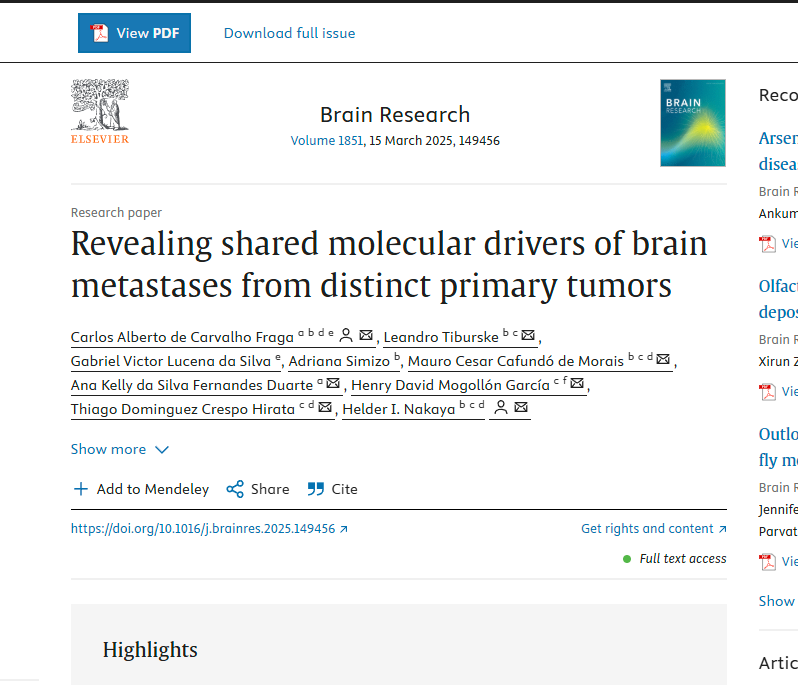Revealing shared molecular drivers of brain metastases from distinct primary tumors.
Brain metastasis is the most common type of brain cancer, associated with significant neurological dysfunction and a poor prognosis. We investigated the transcriptome of 128,421 single-cells of 36 brain metastases, originating from a variety of primary tumors, including melanoma, breast, lung, ovarian, colorectal, and renal cancers. Our aim was to identify common molecular factors across these tumors, shedding light on key interactions that facilitate tumor establishment in the brain. We specifically focused on the dynamics of the blood-tumor barrier and its effects on endothelial cells, pericytes, and astrocytes. Our analysis decoded complex cell-cell communications, emphasizing the crucial role of astrocytes in the tumor microenvironment (TME). This provided insights into how these interactions impact the permeability of the blood-tumor barrier and contribute to the development of brain metastases. We identified the VEGFA, SEMA3, and SPP1 pathways as key regulators in brain metastasis, affecting vascular permeability and cellular dynamics. Spatial transcriptome analysis confirmed our findings and linked these pathways to TME enrichment. The pronounced expression of VEGFA by cancer cells suggests a significant activation of angiogenic pathways, influencing vascular responses and the intricate architecture of brain tissue. The interplay of these signaling pathways underlines the complexity of molecular interactions that define the microenvironment of brain metastases.
Authors
de Carvalho Fraga CA, Tiburske L, Lucena da Silva GV, Simizo A, et al.
External link
Publication Year
Publication Journal
Associeted Project
Network & Precision Medicine
Lista de serviços
-
StructRNAfinder: an automated pipeline and web server for RNA families prediction.StructRNAfinder: an automated pipeline and web server for RNA families prediction.
-
CEMiTool: a Bioconductor package for performing comprehensive modular co-expression analyses.CEMiTool: a Bioconductor package for performing comprehensive modular co-expression analyses.
-
webCEMiTool: Co-expression Modular Analysis Made Easy.webCEMiTool: Co-expression Modular Analysis Made Easy.
-
Assessing the Impact of Sample Heterogeneity on Transcriptome Analysis of Human Diseases Using MDP Webtool.Assessing the Impact of Sample Heterogeneity on Transcriptome Analysis of Human Diseases Using MDP Webtool.
-
Predicting RNA Families in Nucleotide Sequences Using StructRNAfinder.Predicting RNA Families in Nucleotide Sequences Using StructRNAfinder.
-
OUTBREAK: a user-friendly georeferencing online tool for disease surveillance.OUTBREAK: a user-friendly georeferencing online tool for disease surveillance.
-
Noninvasive prenatal paternity determination using microhaplotypes: a pilot study.Noninvasive prenatal paternity determination using microhaplotypes: a pilot study.
-
Editorial: User-Friendly Tools Applied to Genetics or Systems Biology.Editorial: User-Friendly Tools Applied to Genetics or Systems Biology.
-
Automatic detection of the parasite Trypanosoma cruzi in blood smears using a machine learning approach applied to mobile phone imagesAutomatic detection of the parasite Trypanosoma cruzi in blood smears using a machine learning approach applied to mobile phone images
-
Tucuxi-BLAST: Enabling fast and accurate record linkage of large-scale health-related administrative databases through a DNA-encoded approachTucuxi-BLAST: Enabling fast and accurate record linkage of large-scale health-related administrative databases through a DNA-encoded approach
-
Ten quick tips for harnessing the power of ChatGPT in computational biologyTen quick tips for harnessing the power of ChatGPT in computational biology

